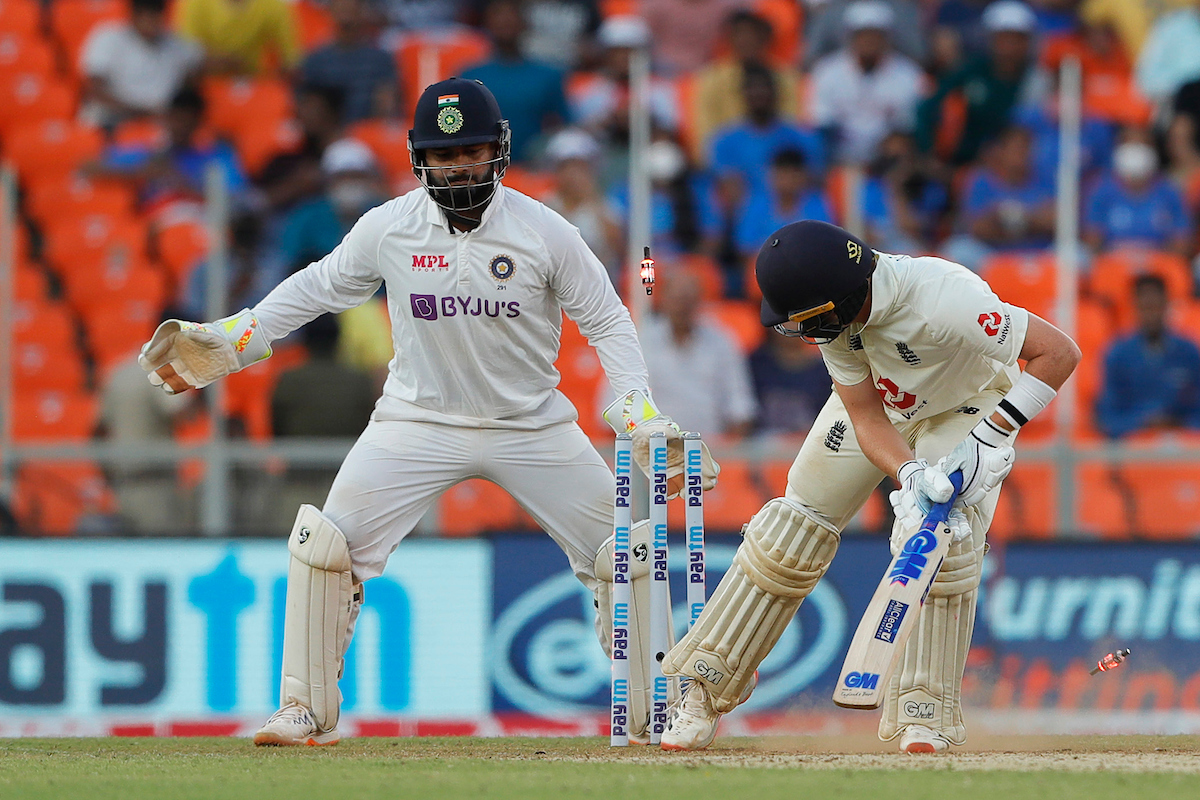'Faith in youth' need of the hour for England as last dance beckons

Dom Sibley averages 21.50 and has passed 20 just once. Ollie Pope averages 18.16, has not passed fifty and has already been dismissed by Ravichandran Ashwin thrice. Zak Crawley has scored a fifty but, barring that one knock, has scores of 9, 8, 5, 13 and 0 in the ongoing sub-continent stretch.
Rory Burns has been dropped mid-way through the series after averaging 14.50 and so has Dan Lawrence, who is the only player among the five to not have passed thirty in a single innings in this series. Each of the five, with the bat, average less than both Ravichandran Ashwin and Dom Bess.
There was always going to be the fear that Chennai was going to be an outlier. There, after winning the toss and batting first in conditions that were not half as threatening as what they’d encountered in Galle, England dug in for 190 overs and amassed 578 runs. Burns, Sibley and Pope all looked comfortable and Lawrence getting out to the pace of Jasprit Bumrah meant that there was no real evidence that he would struggle against spin. Root dominated proceedings with a double-century, yes, but the first innings of Chennai was no one-man-show like Galle; everyone chipped in with handy contributions.
But the warning signs were there. After the pitch deteriorated significantly post Day 3, England were bowled out for 178 in their second innings in under 50 overs. Burns and Sibley were rather easily undone by Ashwin, Lawrence looked fidgety out there in the middle and Pope refused to trust his defence, trying to sweep and reverse-sweep his way out of trouble when confronted by the menace of turn. Yet, given the showing was anyway a significant improvement of what’d unfolded in Sri Lanka, the klaxons were ignored. That England eventually ended up convincingly out-batting, out-bowling and out-playing India also meant that there was no real need for the visitors to introspect and overthink.
Since then, though, what we’ve learnt is that the first innings in Chennai were no real representation of the English batsmen’s - particularly the youngsters - ability against spin. In the five innings post the marathon effort in the first innings of Chennai, England have posted totals of 178, 134, 164, 112 and 81 and have lost a wicket for every 13.38 runs they’ve scored.
In a way, this was coming. One, India was always going to produce rank turners after being unhappy about how toss played a telling hand in the first Test in Chennai and two, the English batsmen were always bound to fail when confronted with a raging spin they’d have never seen in their life before.
Not just in the second innings of Chennai, the warning signs were there in Sri Lanka. Sibley might have scored a fighting fourth innings fifty in the second Test in Galle, yes, but he survived three umpire’s calls en route to that. Up until then, he’d looked like a walking duck, particularly against the left-arm spin of Lasith Embuldeniya, who dismissed him 3/3 times in the first three innings. So it is no surprise that he has fallen twice already, in four innings, to a similar customer in the form of Axar Patel. Chances are that the ‘two’ could have been ‘three’ had he survived the spell of Ishant Sharma in the first session on Day 1 of the third Test.
Crawley, on the other hand, might have a fifty next to his name but he, arguably, is a bigger walking duck than Sibley versus spin, particularly left-arm spin. Four times in the Sri Lanka series he was dismissed under 15 by Embuldeniya and now each of his last six(!!!) dismissals have been against left-arm spinners. The lacquer on the pink-ball might have had a hand in both his dismissals in the third Test, but the four innings across Galle suggest that Crawley’s struggles versus spin can be accounted to more than just the colour of the ball.
And Burns and Pope both came into the series with no competitive cricket whatsoever under their belt, so even if India had produced three flat decks, the duo very well might have struggled to score big. In a way, all these last two Tests have done is speed-up and expose long-standing flaws that were always imminent to bite the side; against spin, this young and inexperienced English line-up was always going to be a ticking time-bomb and that a senior like Ben Stokes did no better than the rookies has stripped the side of any dignity.
But while naturally, the reaction to such debacles would be to overhaul the side and chop and change the players - if not immediately, at least the next time the country visits the subcontinent - England find themselves in a situation where, instead of exerting pressure, there is an imperative need to treat this as a learning experience and back and nurture the current set of players.
It is true that, despite botched team selections and some inconsistent and wayward bowling, it is the batsmen who cost England the series. Had they boasted at least a couple of more batsmen who were proficient enough to not get overwhelmed by spin bowling, they might very well have been ahead in the series. But if the ECB are true to themselves, and are seeking improvement, they wouldn’t try to sugarcoat the poor showings by pinning the blame on the batsmen alone.
For, like a plethora of English journalists have already pointed out multiple times across the past 18 months, it is the system back home - which actively encourages seam and has a disdain for spin, so much so that teams are punished for preparing pitches conducive to spin - that needs an overhaul. But let’s not get into that. Too much has been said and spoken about it already. Rather, it is worth focusing on why the current lot, despite all their shortcomings, might be worth persisting with.
None of Sibley, Crawley, Pope and Lawrence, unless they do something extraordinary in the final Test, are going to come out of this series with their reputation enhanced - let’s make that clear. But that, however, that doesn’t necessarily mean that there has been no effort from their side to make things right.
The sheer will-power and determination of Sibley, for one, has been mighty impressive. He might not have as many runs under his belt as he would have hoped for, but the Sibley who took guard in the second innings in Ahmedabad was a far superior and confident batsman to the one who looked like a walking wicket in the first day of the Sri Lanka tour. His 87 in Chennai is one of the primary reasons why England still have the minutest of chances to level the series and while his shot selection has been poor, his temperament and his defence, more often than not, has been encouraging.
Pope is someone who has looked like he’s yearned for a time in the middle - understandably so, his last professional game before this series came in August and he still might not be 100% fit - and he’s been unlucky to have been raided and outwitted incessantly by vaathi Ashwin, but he’s not been afraid to try a range of things to unsettle the bowler. He, in fact, looked the most assured English batsmen in the first innings of the second Test in Chennai before being undone by a snorter by Siraj which was plucked out of thin air by Pant. Luck has not been on Pope’s side, but, when you watch Pope bat, you always get the feeling that he could be a potential thorn in India’s path.
Lawrence endured a torrid time and to judge Crawley’s progress based on the pink-ball game alone would be harsh, but it has been evident that both are clear in their head about their technique and have their own method which they trust; such clarity will only bode them well in the years to come.
Often, though, people tend to forget just how difficult a place India is to bat in - those, even great batsmen, who have succeeded in maiden attempts are in the minority. Kevin Pietersen averaged 27.62 in his first 8 innings in the country at a time when the pitches were easier and the Indian attack was inferior, while Ricky Ponting reached three figures in India only in the 15th attempt, prior to which he averaged 12.28. In comparison, the English youngsters are faring just about fine, against a superior attack on tougher surfaces.
The last time India dished out these kinds of monstrous pitches was against South Africa in 2015, and it was a series in which everyone not named Ajinkya Rahane averaged below 40. To encounter such raging turners having never played in the subcontinent is one thing, but to then come up against the best ever version of Ashwin and a grenade-thrower like Axar is perhaps the toughest challenge any batsman could come across.
That all of Sibley, Pope, Lawrence and Crawley are the best young batsmen in the country anyway is also more incentive for the ECB to back the quartet to the moon. The first three have been tearing County Cricket apart for multiple seasons now, while Crawley has shown that he is a precocious talent whose natural gift is matched by few across the globe, let alone in the country.
Ultimately, this experience will only mould the batsmen who have been at the receiving end into much, much better cricketers. No simulation can ever match the kind of test they’ve been put through in this series, and given each of these young batsmen are quick learners who have shown a penchant to adapt and improve, they will only benefit from these failures, in the long run.
Virat Kohli described India’s horror 45 minutes in Adelaide as ‘an experience and not a scar’ and should Sibley, Pope, Crawley and Lawrence get the backing they deserve, the quartet, in a few years’ time, might utter the very same words the Indian skipper did, looking back at the tour of India.

Comments
Sign up or log in to your account to leave comments and reactions
0 Comments